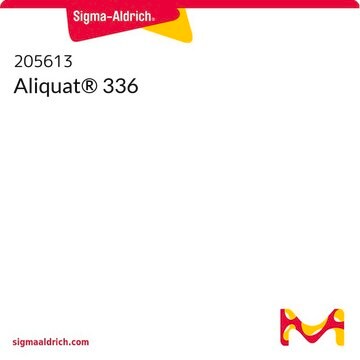255165
Tributylmethylammonium chloride solution
75 wt. % in H2O
Synonym(s):
Methyltributylammonium chloride solution
Sign Into View Organizational & Contract Pricing
All Photos(1)
About This Item
Linear Formula:
CH3N[CH3(CH2)3]3Cl
CAS Number:
Molecular Weight:
235.84
MDL number:
UNSPSC Code:
12352116
PubChem Substance ID:
NACRES:
NA.22
Recommended Products
vapor pressure
7.9 mmHg ( 25 °C)
concentration
75 wt. % in H2O
refractive index
n20/D 1.4682
bp
152 °C
density
0.964 g/mL at 25 °C
SMILES string
[Cl-].CCCC[N+](C)(CCCC)CCCC
InChI
1S/C13H30N.ClH/c1-5-8-11-14(4,12-9-6-2)13-10-7-3;/h5-13H2,1-4H3;1H/q+1;/p-1
InChI key
IPILPUZVTYHGIL-UHFFFAOYSA-M
General description
Tributylmethylammonium chloride (TBMAC) is a quaternary ammonium salt commonly used as a phase-transfer catalyst in various organic synthesis reactions. It can also be used in the preparation of ionic liquids.
Application
Tributylmethylammonium chloride solution is used as a phase transfer catalyst in the synthesis of ɛ-caprolactone by Baeyer-Villiger oxidation of cyclohexanone in the presence of KHSO5 as an oxidizing agent.
Signal Word
Warning
Hazard Statements
Precautionary Statements
Hazard Classifications
Acute Tox. 4 Dermal - Aquatic Chronic 2 - Eye Irrit. 2 - Skin Irrit. 2
Storage Class Code
10 - Combustible liquids
WGK
WGK 2
Flash Point(F)
Not applicable
Flash Point(C)
Not applicable
Personal Protective Equipment
dust mask type N95 (US), Eyeshields, Gloves
Choose from one of the most recent versions:
Already Own This Product?
Find documentation for the products that you have recently purchased in the Document Library.
Enantioselective biocatalytic reduction of 2 H-1, 4-benzoxazines using imine reductases
Zumbra?gel N, et al.
The Journal of Organic Chemistry, 84(3), 1440-1447 (2018)
New and efficient technique for the synthesis of ?-caprolactone using KHSO5 as an oxidising agent in the presence of a phase transfer catalyst
Baj S, et al.
Applied Catalysis A: General, 395(1-2), 49-52 (2011)
Paula Ossowicz et al.
Molecules (Basel, Switzerland), 24(18) (2019-09-11)
Ionic liquids based on different l-amino acids (glycine, l-valine, l-leucine, l-isoleucine, l-histidine, l-methionine, l-tyrosine, l-tryptophan, l-arginine, and l-threonine) and different cations (tetrabutylammonium (TBA), tributylmethylammonium (tBMA), didecyldimethylammonium (DDA), (2-hydroxyethyl)trimethylammonium (choline) (Chol), alkyl(C12-C14) dimethylbenzylammonium (benzalkonium) (BA), dodecyltrimethylammonium (DDTMA), hexadecyltrimethylammonium (HDTMA), octadecyltrimethylammonium (ODTMA)
J W Smit et al.
British journal of pharmacology, 123(3), 361-370 (1998-03-21)
1. In the present study it was tested whether known P-glycoprotein (P-gp) substrates/MDR reversal agents interact with small (type 1) and bulky (type 2) cationic drugs at the level of biliary excretion in the rat isolated perfused liver model (IPRL).
Min-Koo Choi et al.
Journal of pharmaceutical sciences, 94(2), 317-326 (2004-12-01)
The in vivo canalicular excretion clearance of tributylmethyl ammonium (TBuMA), a P-glycoprotein (P-gp) substrate, was previously reported to be unaffected by the induction of an experimental hepatic injury (EHI) by CCl(4) despite the increased expression of P-gp in the EHI
Our team of scientists has experience in all areas of research including Life Science, Material Science, Chemical Synthesis, Chromatography, Analytical and many others.
Contact Technical Service










